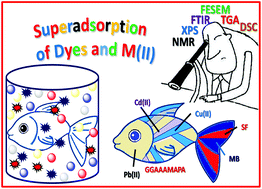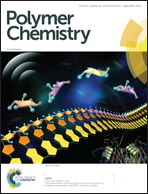Synthesis of guar gum-g-(acrylic acid-co-acrylamide-co-3-acrylamido propanoic acid) IPN via in situ attachment of acrylamido propanoic acid for analyzing superadsorption mechanism of Pb(ii)/Cd(ii)/Cu(ii)/MB/MV†
Abstract
For the first time, guar gum-g-(acrylic acid-co-acrylamide-co-3-acrylamido propanoic acid) (GGAAAMAPA), a smart environment-friendly and sustainable interpenetrating polymer network hydrogel having unprecedented thermomechanical/physicochemical properties and excellent recyclability, has been synthesized by the grafting of guar gum (GG) and in situ adjunct allocation of 3-acrylamido propanoic acid (APA) during solution polymerization of acrylic acid (AA) and acrylamide (AM), using N,N′-methylenebisacrylamide (MBA) and potassium persulfate (PPS)–sodium bisulfite (SBS) as a crosslinker and a redox pair of initiators, respectively, through systematic multistage optimization of the constituents and the temperature of the reaction, for a comprehensive understanding of the individual/synergistic superadsorption mechanism during recycling of hazardous dyes, like 2,8-dimethyl-3,7-diamino-phenazine (i.e. safranine, SF), 3,7-bis(dimethylamino)-phenothiazin-5-ium chloride (i.e. methylene blue, MB) and sodium 4{[4(dimethylamino)phenyl]diazenyl}benzene-1-sulfonate (i.e. methyl orange, MO), along with the adsorptive exclusion of metal ions, i.e. M(II), like Pb(II), Cd(II) and Cu(II). The unambiguous in situ addition of APA, the grafting of GG into the AA-co-AM-co-APA (AAAMAPA) matrix and the superadsorption mechanism have been systematically determined by extensive analyses of FTIR, 1H-/13C-NMR, O 1s-/N 1s-/C 1s-/Pb 4f7/2,5/2-/Cd 3d5/2,3/2- and Cu 2p3/2,1/2-XPS, TGA, DSC, XRD, FESEM, EDX, and storage/loss moduli and supported by computational measurements via density functional theory (DFT), along with the measurements of %gel content (%GC), pH at point of zero charge (pHPZC), %graft ratio (%GR) and network parameters of hydrogels. The prevalence of ionic (I) and variegated interactions, like monodentate (M), bidentate bridging (BB) and bidentate chelating (BC), between GGAAAMAPA and M(II), has also been rationalized by FTIR and fitting of kinetics data to the pseudosecond order model and by the measurement of activation energies of adsorption. The individual/interactive effects of cationic and/or anionic dyes have been rationally determined via extensive UV-Vis analyses at 1 : 1, 1 : 2 and 2 : 1 mole ratios of dyes and pHi = 2/9, interpreted through the appearance of the metachromic effect, dye-aggregates, π–π stacking interaction, diprotonated MO etc. The BET and Langmuir isotherms have fitted the best to MB and SF/Cd(II)/Cu(II)/Pb(II), respectively. Thermodynamically spontaneous chemisorption processes have shown the maximum adsorption capacities (ACs) of 27.06, 39.35, 40.55, 39.42, and 41.98 mg g−1 for MB, SF, Cd(II), Cu(II) and Pb(II), respectively, at 303 K, adsorbent dose = 0.025 g and initial concentration of dyes/M(II) = 30 ppm.



 Please wait while we load your content...
Please wait while we load your content...